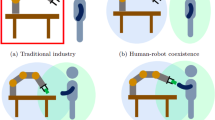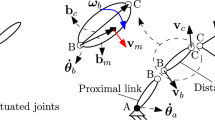Abstract
This work presents a method of predicting the calibration accuracy of a 3-DoF, 2-cable, planar cable-driven parallel robot (CDPR). The calibration is realized with the combination of a laser displacement sensor and an inclinometer attached to the moving-platform, as well as the cable encoders. The actual accuracies of the sensors are first experimentally determined for higher calibration quality. Simulation of the calibration are performed from 6 to 50 measurement poses, with 500 repetitions for each pose number to avoid outliers. The simulation results show that the error on the CDPR parameters decreases with the number of calibration poses considered, reaching a plateau of ± 9 mm of error after approximately 40 poses. The effect of each sensor on the calibration accuracy is studied. Calibration experiments are carried out for a 5.2 m-span CDPR. After verification by an accurate laser tracker, the calibration results match the previous simulation.
































Similar content being viewed by others
References
An H, Liu H, Liu X, Yuan H (2022) An all-in-one cable-driven parallel robot with flexible workspace and its auto-calibration method. In: 2022 IEEE/RSJ international conference on intelligent robots and systems (IROS), pp 7345–7351
Picard E, Plestan F, Tahoumi E, Claveau F, Caro S (2021) Control strategies for a cable-driven parallel robot with varying payload information. Mechatronics 79:102648
Gagliardini L, Caro S, Gouttefarde M, Girin A (2016) Discrete reconfiguration planning for Cable-Driven Parallel Robots. Mech Mach Theory 100:313–337. https://doi.org/10.1016/j.mechmachtheory.2016.02.014
Li H, Zhang X, Yao R, Sun J, Pan G, Zhu W (2013) Optimal force distribution based on slack rope model in the incompletely constrained cable-driven parallel mechanism of FAST telescope. Cable-Driven Parallel Robots, 87–102. https://doi.org/10.1007/978-3-642-31988-4_6
Picard E, Caro S, Claveau F, Plestan F (2018) Pulleys and force sensors influence on payload estimation of cable-driven parallel robots. In: 2018 IEEE/RSJ international conference on intelligent robots and systems (IROS 2018). https://hal.archives-ouvertes.fr/hal-01862015
Wang J, Masory O (1993) On the accuracy of a Stewart platform. I. The effect of manufacturing tolerances. In: Proceedings IEEE international conference on robotics and automation, vol 1, pp 114–120
Daney D, Papegay Y, Neumaier A (2004) Interval methods for certification of the kinematic calibration of parallel robots. In: Proceedings—IEEE international conference on robotics and automation, pp 1913–1918
Zhang F, Shang W, Li G, Cong S (2021) Calibration of geometric parameters and error compensation of non-geometric parameters for cable-driven parallel robots. Mechatronics 77:102595. https://doi.org/10.1016/j.mechatronics.2021.102595
Klimchik A, Pashkevich A, Wu Y, Caro S, Furet B (2012) Design of calibration experiments for identification of manipulator elastostatic parameters. arXiv:1211.6101
Verner M, Xi F, Mechefske C (2005) Optimal calibration of parallel kinematic machines. J Mech Des Trans ASME 127:62–69
Wu Y, Klimchik A, Caro S, Furet B, Pashkevich A (2015) Geometric calibration of industrial robots using enhanced partial pose measurements and design of experiments. Robot Comput Integr Manufact 35:151–168
Qian S, Bao K, Zi B, Wang N (2018) Kinematic calibration of a cable-driven parallel robot for 3D printing. Sensors (Switzerland) 18:2898
Zhang Z, Xie G, Shao Z, Gosselin C (2022) Kinematic calibration of cable-driven parallel robots considering the pulley kinematics. Mech Mach Theory 169:104648
Sandretto J, Daney D, Gouttefarde M (2013) Calibration of a fully-constrained parallel cable-driven robot. In: CISM international centre for mechanical sciences, courses and lectures, vol 544, pp 77–84
Boggs P, Byrd R, Schnabel R (1987) A stable and efficient algorithm for nonlinear orthogonal distance regression. SIAM J Sci Stat Comput 8:1052–1078. https://doi.org/10.1137/0908085
Miermeister P, Pott A, Verl A (2012) Auto-calibration method for overconstrained cable-driven parallel robots. In: 7th German conference on robotics, ROBOTIK 2012, pp 301–306
Borgstrom P, Jordan B, Borgstrom B, Stealey M, Sukhatme G, Member S, Batalin M, Kaiser W, Member S (2009) A cable-driven robot with self-calibration capabilities, NIMS-PL
Zhuang H, Masory O, Yan J (1995) Kinematic calibration of a Stewart platform using pose measurements obtained by a single theodolite. In: IEEE international conference on intelligent robots and systems, vol 2, pp 329–334
Martin C, Fabritius M, Stoll J, Pott A (2021) A laser-based direct cable length measurement sensor for CDPRS. Robotics 10:1–11
Klimchik A, Wu Y, Caro S, Furet B, Pashkevich A (2014) Geometric and elastostatic calibration of robotic manipulator using partial pose measurements. Adv Robot 28:1419–1429
Renaud P, Andreff N, Martinet P, Gogu G (2005) Kinematic calibration of parallel mechanisms: a novel approach using legs observation. IEEE Trans Robot 21:529–538
Zhuang H, Liu L, Masory O (2000) Autonomous calibration of hexapod machine tools. J Manuf Sci Eng Trans ASME 122:140–148
Andreff N, Renaud P, Martinet P, Pierrot F (2004) Vision-based kinematic calibration of an H4 parallel mechanism: practical accuracies. Ind Robot 31:273–283
Pierrot F, Marquet F, Company O, Gil T (2001) H4 parallel robot: modeling, design and preliminary experiments. In: Proceedings 2001 ICRA. IEEE international conference on robotics and automation (Cat. No.01CH37164), vol 4, no 4, pp 3256–3261
Wang B, Cardou P, Caro S (2022) An approach for predicting the calibration accuracy in planar cable-driven parallel robots. Adv Robot Kinemat 2022:110–121
Wang B, Caro S (2021) Exit point, initial length and pose self-calibration method for cable-driven parallel robots. Mech Mach Sci 103:90–101
Abbasnejad G, Carricato M (2015) Direct geometrico-static problem of underconstrained cable-driven parallel robots with n cables. IEEE Trans Robot 31:468–478
Fortin-Côté A, Cardou P, Gosselin C (2014) An admittance control scheme for haptic interfaces based on cable-driven parallel mechanisms. In: Proceedings—IEEE international conference on robotics and automation, pp 819–825
Choi S, Park K (2018) Integrated and nonlinear dynamic model of a polymer cable for low-speed cable-driven parallel robots. Microsyst Technol 24:4677–4687. https://doi.org/10.1007/s00542-018-3820-7
Piao J, Jin X, Jung J, Choi E, Park J, Kim C (2017) Open-loop position control of a polymer cable-driven parallel robot via a viscoelastic cable model for high payload workspaces. Adv Mech Eng 9:1–12
Nanthacoumarane S, Wang B, Kouadri-Henni A, Cardou P, Caro S (2022) Polymer cable characterization in cable-driven parallel robots. 25ème Congrès Français De Mécanique Nantes. https://hal.science/hal-03758221
Baklouti S, Courteille E, Caro S, Dkhil M (2017) Dynamic and oscillatory motions of cable-driven parallel robots based on a nonlinear cable tension model. J Mech Robot 9:1–14
Acknowledgements
This work was supported by the ANR CRAFT project, grant ANR-18-CE10-0004, https://anr.fr/Project-ANR-18-CE10-0004. The first author of the paper is grateful for the support of China Scholarship Council (CSC Grant No. 202008070051).
Author information
Authors and Affiliations
Corresponding author
Ethics declarations
Conflict of interest
The authors declare that they have no conflict of interest.
Additional information
Publisher's Note
Springer Nature remains neutral with regard to jurisdictional claims in published maps and institutional affiliations.
Rights and permissions
Springer Nature or its licensor (e.g. a society or other partner) holds exclusive rights to this article under a publishing agreement with the author(s) or other rightsholder(s); author self-archiving of the accepted manuscript version of this article is solely governed by the terms of such publishing agreement and applicable law.
About this article
Cite this article
Wang, B., Cardou, P. & Caro, S. An approach for predicting the calibration accuracy in planar cable-driven parallel robots and experiment validation. Meccanica 58, 2177–2196 (2023). https://doi.org/10.1007/s11012-023-01720-y
Received:
Accepted:
Published:
Issue Date:
DOI: https://doi.org/10.1007/s11012-023-01720-y




